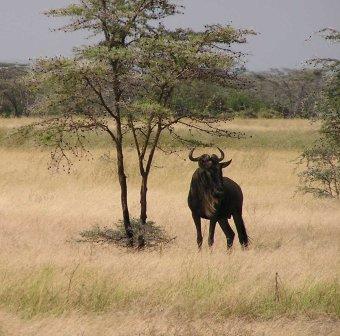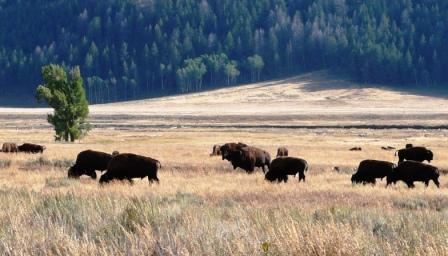The total number of wildebeest left in all of southern Africa is estimated at about 2.5 million individuals, with just over half of those participating in the Serengeti/Maasai Mara migration that has captured the fascination and imagination of the world for decades. It is quite a spectacle, and it is the largest display of mobile mammal flesh anywhere on the planet.
Is the “Greatest Migration on Earth” really that impressive, though? Or is it just a symbol of the sad state we have gotten our planet into?
Let’s put it into perspective by traveling to the Great Plains of the United States in the 1700s. At that time there were an estimated 70 million bison on the plains. That is 28 times more bison than there are wildebeest in southern Africa. A single migratory herd of bison could contain as many as 4 million animals, covering the Plains as far as the eye could see.
By the mid-1800s, those massive herds had been reduced to less than one thousand animals through hunting and targeted eradication plans. Even now, after decades of conservation efforts, the largest wild herd of American bison is the 5,000 or so found in Yellowstone National Park. The total number of “wild” bison (existing on conservation lands rather than farms) is around 15,000 to 30,000. That is a far cry from 70 million.
According to the Save the Serengeti coalition, the proposed Serengeti Highway could potentially reduce the migratory wildebeest herd from 1.3 million to 200,000 in the not-so-distant future.
Allow me to play Devil’s Advocate here for a moment and ask “Who cares?” Do you ever hear people lamenting the loss of the great herds of American bison and the disappearance of that truly massive migration? Had you ever even heard about it before reading this post?
The introduction of the Serengeti Highway is really not so different from the introduction of the railroad to the Great Plains. The train brought access to the western frontier areas of the North American continent and arguably brought great prosperity through that access. So what if a few bison got eliminated along the way?
If the Serengeti Highway project goes forward and we lose the wildebeest migration, will people even remember it existed 50 years from now? Will anybody care?
Mark D. Jordahl – Kampala









[…] So what’s the reason for the road? Commercial interests obviously and an article in the Tanzanian News would suggest this. Where’s the money coming from – probably China, due to the huge natural resources in and around Tanzania. The road would only be 40 miles in length, but it would be the end of the road for the Great Migration in a similar way to the Bison migrations in North America. At one time over 70miliion Bison roamed the Great Plains of North America, they are now down to 15,000 to 30,000 and how many people really care about that – this blog makes an interesting read. […]
I care. I care because there is nothing I could have done about the disruption of the American bison migration in an era before non-native Americans enraptured by the possibilities of the Industrial revolution began to develop an environmental consciousness. However, to me this is my “bison migration” and having visited Africa I am a non-native African, lol. I care for the people this road will harm but also those this road will help plus the wildlife and ecosystems that could be affected.
The numbers of wildebeest has never plummeted questions of what will happen arise in my mind. Will it be written off the same as the American bison or will the ecosystem crumble? Can TZ, Kenya or Uganda afford for it to crumble? While the biological make up of the wildebeest don’t suggest that they would fold like the passenger pigeon, is it possible? I can’t profess that I know a lot about the ecology of wildebeest but how would they stack up with smaller numbers against predators with the main predator being poaching?
I care because I don’t know how detrimental this road could be however I feel that the risks (especially with the presence of alternatives) outweigh the good and would rather that the last remaining great (terrestrial) migration isn’t jeopardized for minimum convenience. Thanks for your article.
Well said!
Mark
Did the railroad really kill the bison ? I suppose they were shot mostly for many reasons… Many millions could have been saved even with railroad and roads in place…assuming some conservation efforts. Those did not exist back then but do now and can be perhaps utilized (e.g. southern alternative for the highway)
Railroads don’t kill bison…people with railroads kill bison. (sorry if that reference doesn’t translate outside of the U.S. and the pro-gun lobby). You are absolutely right that the railroad itself didn’t kill the bison. But, it provided the access that was needed by a government intent on killing the bison in order to exterminate the Native Americans who relied on the bison for their survival. It is true that we need to examine the deeper intentions of the decision-makers. If we don’t look at why – exactly – the Tanzanian government wants this northern route, any proposed alternative will fall on deaf ears.
The numbers are shocking. Bison and Wildebeest depletion are only two examples of our destruction of the planet. After thousands of years, why haven’t the beasts become the hunter, and people the hunted?
Maybe that will come in time. Here in Uganda in the early 1900s, there was a sleeping sickness epidemic where whole villages were stricken. So many people were bedridden that lions would walk right into huts and pull people off their beds. I suppose if we weaken our life-support system (i.e. earth) enough, it could happen on a larger scale.
Mark D. Jordahl Conservation Concepts 256 775 295 126 Blog: https://conserveuganda.wordpress.com Website: http://www.ConservationConcepts.net
“Give me a Wildness whose glance no civilization can endure.” – Henry David Thoreau
To stir the pot more, how would American society 200 years ago reacted if a foreign power asked/told us not to build railroads, developed further west or exterminate bison because they were a “world resource”?
These things are never straightforward, are they?
Mark
I did know about the bison disappearance, and have seen the ‘big’ herd in Yellowstone … so I do care and hope others will join me to prevent the same happening to the Serengeti what happened to the herds of the great plains 200 years ago …
I couldn’t resist stirring the pot a bit. I hope others will feel the same way you do.
Mark D. Jordahl